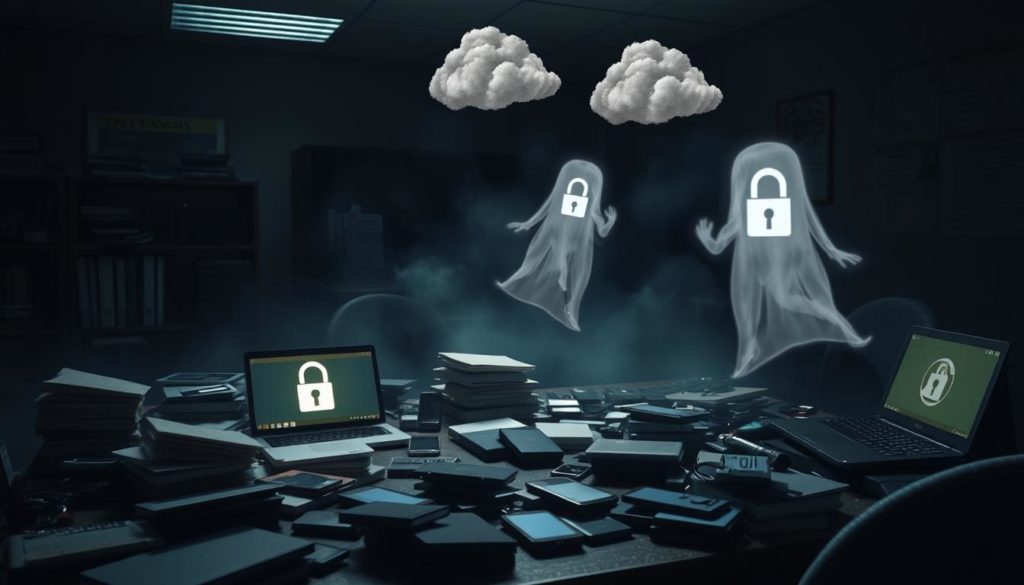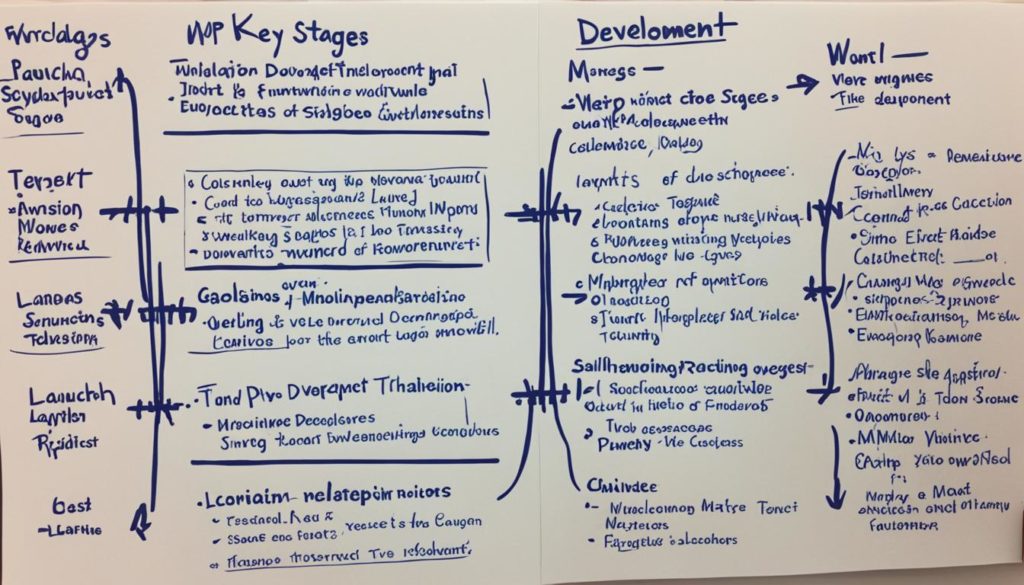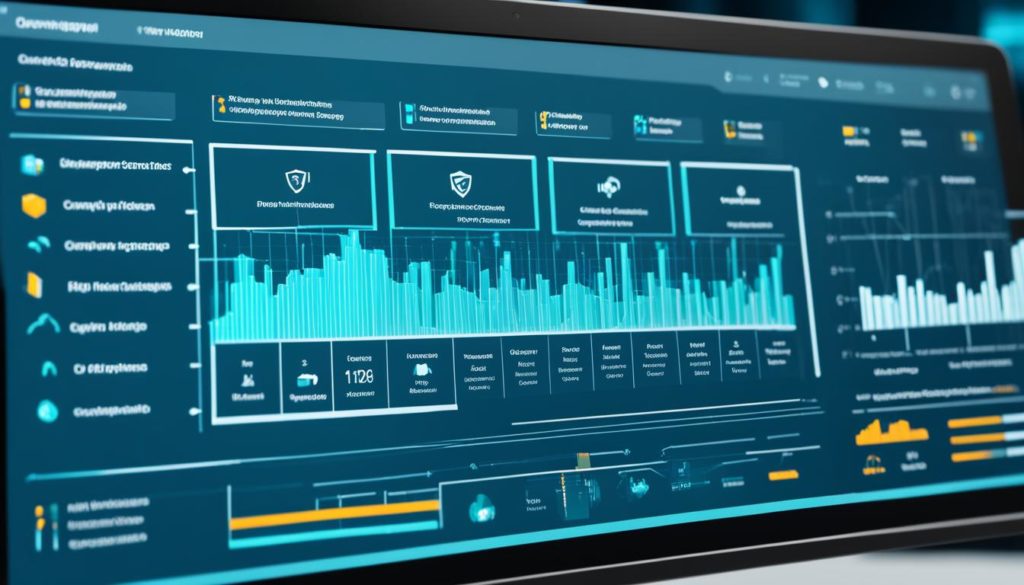
Did you know 41% of enterprise employees use unauthorized tech in 2023, says Gartner? This shows how big a problem Shadow IT is today.
Shadow IT means using tech without IT’s okay. With more SaaS, managing it gets harder. Companies are spending a lot on cloud services, with Gartner saying it will hit nearly $600 million this year.
This makes it crucial to manage Shadow IT well. Employees use unauthorized apps to work faster. But this can lead to security and compliance issues. We need strong Shadow IT solutions to protect our businesses.
Understanding Shadow IT is key for success. We need to know its risks and how to manage it. Let’s look at how to handle Shadow IT in our businesses.
For more on handling these challenges, check out this guide on navigating Shadow IT risks.
Key Takeaways
- 41% of enterprise employees engage in shadow IT activities.
- Gartner predicts cloud spending to reach $600 million in 2023.
- Shadow IT encompasses unauthorized software and hardware use.
- Effective shadow IT governance mitigates security and compliance risks.
- Understanding and managing shadow IT is essential for modern businesses.
Understanding Shadow IT
Shadow IT is when people use technology not approved by their company. This can lead to big security risks. It can cause data breaches, break rules, and make things less efficient.
Definition and Common Examples of Shadow IT
Shadow IT includes many types of unauthorized tech. It often slips past IT teams. For example, using Dropbox or Google Drive without permission is common. Or, using personal devices for work.
Another example is storing company data in unauthorized cloud spaces.
Why Shadow IT Is Growing in Prevalence
Many things make shadow IT more common. ESG’s State of Attack Surface Management 2022 found nearly 7 in 10 organizations hit by shadow IT in 2021 and 2022. Gartner says 38% of tech buys are made by business leaders, not IT.
This makes it hard for IT to keep track of all tech. SaaS apps are also growing fast, making work easier but also more prone to shadow IT. OAuth apps can access important data, adding to the risk.
All these factors lead to more IT being used outside of official channels. This wastes time and resources.
| Factor | Impact |
|---|---|
| Rapid SaaS Adoption | Higher efficiency and quicker workflows but increased unsanctioned app usage. |
| Business-Led Technology Purchases | 38% of tech purchases not overseen by IT, leading to security blind spots. |
| OAuth-enabled Apps | Risks due to permissions allowing access to sensitive data. |
| Consumerization of IT | Hundreds of network-accessed shadow IT applications increase vulnerabilities. |
| App Sprawl | Wasted time and resources, presenting collaboration and communication challenges. |
| Lack of Visibility | Significant security gaps arise from unrecognized shadow IT applications. |
Risks of Shadow IT in Organizations
Shadow IT in organizations brings many challenges and risks. If not managed, these can harm the business a lot. Knowing the main risks helps us find ways to deal with them.
Data Breaches and Unauthorized Access
Shadow IT increases the risk of data breaches. When employees use apps without permission, it creates security holes. This can lead to data loss, theft, and malware.
Also, shadow IT can bring in bad code, raising the risk of ransomware attacks. To fight these threats, we need to watch closely and use strong security tools like CrowdStrike Falcon Cloud Security.
Compliance and Regulatory Risks
Shadow IT also poses big compliance risks. Apps not approved might not follow rules like GDPR or PCI-DSS. This could lead to fines and legal trouble.
Not following rules can also cause system failures and data problems. It’s key to check IT activities and policies often to avoid these issues.
Business Inefficiencies and Increased Costs
Shadow IT can make things less efficient and cost more. Using apps without permission can waste resources and lower tech value. It can also lead to spending on the same tools twice.
While it might help employees work better, the lack of control can cause big problems. IT teams should work on seeing and managing assets better.
In short, shadow IT can help productivity but also brings risks like data breaches, compliance issues, and higher costs. By understanding these risks, we can create plans to keep our organizations safe.
Reasons People Use Shadow IT
There are many reasons for shadow IT in companies. One big reason is that current IT services don’t meet everyone’s needs. When departments feel ignored, they find their own IT solutions, leading to shadow IT.
Not knowing about IT rules or choosing to ignore them also plays a big part. Some workers might not see the dangers of downloading apps, which can cause big problems like data breaches.
Some business areas need their own IT, leading to shadow IT. Also, power struggles and egos can create separate IT groups. To stop shadow IT, IT teams need to watch what employees do closely.
Employees want to work better and faster. About 80% use unauthorized software to do their jobs easier. But, experts say shadow IT doesn’t really help.
Nicolas Desmarais says shadow IT risks have grown with AI. Workers use AI tools without rules, making problems worse. To fight shadow IT, companies should give workers the tools they need. This way, workers won’t feel the need to use unauthorized software.
Key Strategies for Managing Shadow IT
Managing shadow IT needs a mix of steps to boost visibility, improve IT, and monitor closely. We’ll explore key strategies for tackling shadow IT’s challenges.
Improving Asset Visibility
Controlling shadow IT starts with knowing what tech you have. Keeping a detailed list of all tech assets is key. Use tools for constant monitoring and network scans to find hidden tech.
Also, having a company policy that’s seen as helpful, not strict, can work well.
Upgrading IT Service Management Practices
Improving ITSM is crucial to fight shadow IT. Make IT more responsive to what users need. This way, people are less likely to use unauthorized apps.
Using a unified ITSM system helps operations stay agile and services get delivered on time. This is especially important as Gartner says many cyberattacks will target shadow IT this year.
Implementing Shadow IT Monitoring Measures
It’s important to monitor shadow IT to find and manage unauthorized apps. Use automated tools to spot unauthorized software fast. Adding security like VPNs, MFA, and antivirus helps a lot.
Also, doing risk assessments, network scans, and training on cybersecurity is key, especially with more remote work.
By working on visibility, ITSM, and monitoring, you can lower risks from unauthorized apps. This makes for a safer and more efficient IT setup.
Best Practices in Shadow IT Governance
Effective shadow IT governance is key to balancing benefits and risks. Clear shadow IT policies are the base, defining what’s okay and ensuring security. They guide what’s allowed and what’s not.
Creating and Enforcing Shadow IT Policies
Creating detailed policies is crucial for shadow IT management. These policies should be shared with all employees, stressing the need to follow guidelines. Regular audits and monitoring help catch and fix any issues.
Creating a culture of learning and responsibility is important. It encourages employees to follow the rules.
Providing Alternatives with Low-Code Tools
Offering sanctioned low-code tools can meet employee needs. These tools let users make apps without needing to code. This way, innovation stays within approved IT boundaries.
Platforms like Microsoft Power Apps or Google App Maker are good options. They help avoid unauthorized tools while keeping data safe.
Streamlining Software Approval Processes
Streamlining software approval is vital for shadow IT management. Making the approval process faster and clearer can stop employees from using unauthorized tools. A simple, efficient workflow and user feedback can improve this process.
Tools like Bitsight Attack Surface Analytics help find and fix shadow IT risks. This ensures only safe, approved apps are used in the IT system.
FAQ
What is Shadow IT?
Shadow IT is when employees use technology without IT’s okay. This includes apps or cloud services not approved by IT. It’s like using something without asking.
Why is Shadow IT becoming more prevalent?
Shadow IT grows because of new SaaS apps and the need for better work tools. Sometimes, IT is slow to approve new tech. Employees use their own tools to work better.
What are the main security risks associated with Shadow IT?
Shadow IT can cause big security problems. It can lead to data leaks because of untested apps. Also, these tools might not be safe, as IT didn’t check them.
How can Shadow IT affect compliance and regulatory requirements?
Using apps not approved by IT can break rules like GDPR. This can lead to big fines and legal trouble.
Can Shadow IT lead to business inefficiencies and increased costs?
Yes, Shadow IT can make things less efficient and cost more. It can waste resources and money on tools that aren’t needed.
What are some common reasons employees use Shadow IT?
Employees might use Shadow IT if current tools don’t work well. Or if they can’t get new tools fast enough. They might not know the risks and just want to work better.
How can we improve asset visibility to manage Shadow IT?
To see all technology, keep a detailed list of everything. Use tools to watch the network and apps. This helps find and control tools not approved by IT.
What role does IT Service Management (ITSM) play in reducing Shadow IT?
Good ITSM makes IT work better and faster. It helps stop unauthorized apps by being more open to user needs. It also makes getting new tools easier.
What measures can we take to monitor and manage Shadow IT effectively?
Use network and app tracking to find and control unauthorized tools. Also, have a strong ITSM system to manage all IT needs.
How can we create and enforce policies to govern Shadow IT?
Make clear rules about what tech is okay. Check these rules often and teach employees about them. This keeps everyone in line.
How can low-code tools help in managing Shadow IT?
Low-code tools are a good choice for users who want to make their own apps. They let employees create solutions without going around IT.
What are some best practices for streamlining the software approval process?
Make getting new software faster and clearer. Make sure everyone knows how it works. Also, add approved tools safely to your IT system. This stops the need for unauthorized apps.
Future App Studios is an award-winning software development & outsourcing company. Our team of experts is ready to craft the solution your company needs.










